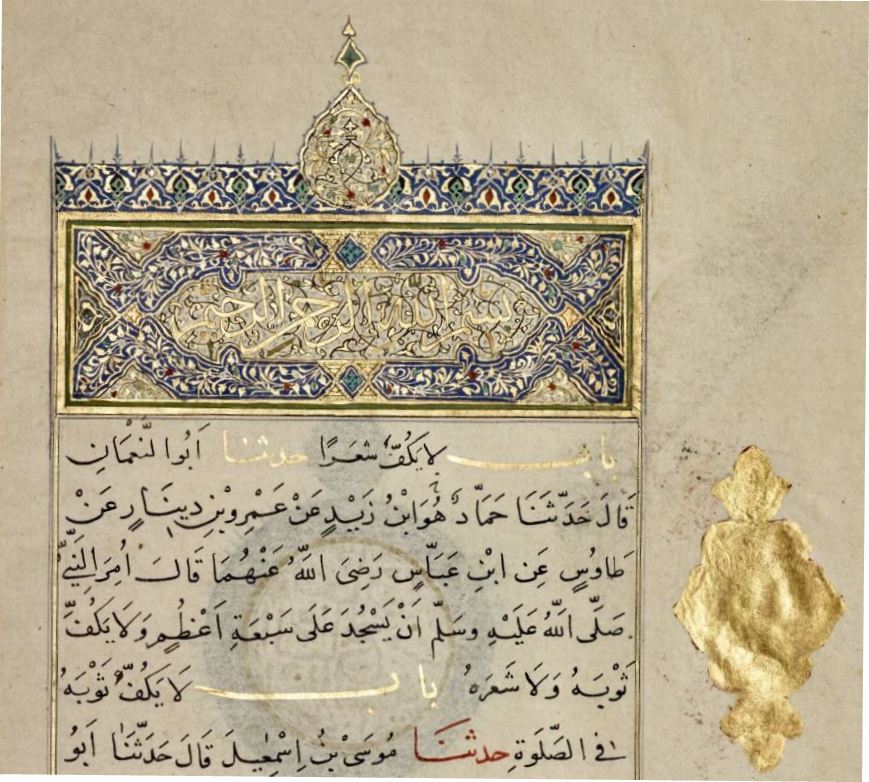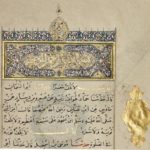
The number of hadiths that al-Bukhārī wrote (or transmitted) lies somewhere between 250,000 and one million. Of these he included 7,593 in his collection. Of these, there is a total of 2,762 of separate hadiths (excluding hadiths that are largely repetitions) – and all within a timescale of but one and a half years. Most of these hadiths are based on those narrated by Abū Hurayra, ʽĀ’isha and al-ʽAbbās. The Ṣaḥīḥ al-Bukhārī collection[1] is marked by a contradiction between the prophetic hadiths and the Qur’ānic Text, and it offends both Islam as a religion and the Prophet as a human being.
THE QUR’ĀN CONFIRMS the need to speak and dialogue with the ‘People of the Book’[2] in the best possible way: “and argue with them in the best way.” [3] Al-Bukhārī’s work, on the other hand has the Prophet commanding Muslims: “Do not initiate peace with the Jews and Christians, and if you meet them on the road, force them into the narrowest way.” [4]
What are we to believe: the Qur’ān or al-Bukhārī? Another hadith attributed to the Prophet in the Ṣaḥīḥ al-Bukhārī threatens the people of Quraysh and its clan with killing and slaughter by saying: “I have come to you with slaughter,” [5] while the text of the Qur’ānic verse says: “And we did not send you except as a mercy to the worlds.” [6] Was the Prophet sent to slaughter people and threaten them with death, or is he a prophet of mercy who forgives, who exhibits mercy and pardons his enemies?
Now these contradictions and insults to the Prophet are fully sanctified by the shaykhs of Al-Azhar. So which is the correct text? And if al-Bukhārī contradicts the Qur’ān, why is his Ṣaḥīḥ considered to be the most authentic book after the Qur’ān?
There is prophetic hadith contradiction included in Ṣaḥīḥ al-Bukhārī concerning a period of a pregnancy, given as four years following the death of the husband, while in the Qur’ān we have: his mother carried him against his will and gave birth against him, and his pregnancy and weaning are thirty months)! [7] How did it come to be four or five years and the shaykhs believe it because it is written in al-Bukhārī? And yet they say that it is the most authoritative book after the Qur’ān. Now, does it agree with the Qur’ān or does it contradict it?
If al-Bukhārī contradicts the Qur’ān, why is his Ṣaḥīḥ considered to be the most authentic book after the Qur’ān?
There are passages in the Qur’ān that take the form: “there is no compulsion in religion” [8] and “you have your religion and I have my religion”,[9] whereas in the Ṣaḥīḥ al-Bukhārī a hadith of the Prophet was recorded which is contrary to this: I was commanded to fight all people until they bear witness…” [10] Then there is his hadith inciting killing: “Whoever changes his religion, kill him”.[11] Are we to believe the Qur’ān or al-Bukhārī with his portrayal of the Prophet as a bloodthirsty murderer?
Al-Bukhārī offends the Prophet when he writes about his sexual prowess, that he possesses the sexual potency of thirty or forty men, and that he used to do the rounds of his wives and have intercourse with all of them in a single night. And washing himself only once! Is this to praise the Messenger or defame him and denigrate his humane values?
As for contempt of women, and their ‘inferiority’ in the hadiths included in the Ṣaḥīḥ collectionsof al-Bukhārī and Muslim, this is unashamedly accepted as a given: the wife is to lick the pus and blood of her husband’s wounds, to fulfil his rights over her, and be satisfied with her! [12]
Woman is equated with a black dog or an ass in her capacity to nullify a man’s prayer should they pass in front of him. There are many other hadiths like this. Indeed, there is also verse in the Qur’ān where it is mentioned that only sickness or defecation take precedence over womankind in the sequence of conditions requiring ablution:
“And if you are sick, or on a journey, or one of you come from the privy or you have touched the women, and you cannot find water, betake yourselves to pure earth, then wipe your faces and your hands; surely Allah is Pardoning, Forgiving.” [13]
Is this a tribute to womankind? And is this also the word of God, or is it the word of human beings?
There is no such thing as ‘torment in the grave’. The very idea of torment is an insult to the Most High, the Almighty – for whom mercy for His servants is to be assumed – and it only associates religiosity with fear, both in this world and in the Hereafter. It is nothing more than the fantasy of the shaykhs. There is no evidence in existence to confirm what takes place after death.
As for the legend of the bald snake, has anyone actually seen a snake with hair so that we can believe in the existence of a bald snake? The story is nothing but a legend promulgated by shaykhs and mythographers to ensure willing submission to them, to safeguard their income and to perpetuate their profitable trading with the minds of the simple and the ignorant.
Can we seriously believe that a writer has been able to transmit accurately hadiths dating from over 150 years following the death of the one who spoke them?
The Ṣaḥīḥ al-Bukhārī is a work that offends both the Prophet and Islam, and makes claims that are completely rejected by Shaykh Muhammad Farḥān, Islam Buhairi, and Aḥmad ʽAbdo Māhir. Yet instead of engaging in a scientifically objective and critical review of the work, and of the way it incites contempt for other religions, we see the shaykhs of Al-Azhar specializing in mounting desperate defenses of the authenticity of al-Bukhārī and Muslim’s hadith collections, and claiming that they remain the most authoritative works after the Qur’ān itself. The greatest calamity is that the Al-Azhar institution issued a statement forbidding any engagement in such discussions and criticisms injurious to Ṣaḥīḥ collections of al-Bukhārī and Muslim, and holding that such discussions violate national security! While it is in fact books such as these that are disdaining the religion of Islam and attributing disgraceful behavior to the Prophet.
The roots of the threat to public security are to be found in the curricula of the religious institution that incite extremism and hatred, and explicitly call for the takfīr of those who differ in faith – something which only stirs up strife and division between the inhabitants of Egypt, Muslim and Christian, who have been living there for thousands of years.
The Al-Azhar institution and its shaykhs, with the support of the state – and particularly now that it has infiltrated the judicial authorities and courts – has turned into a sword of Damocles hanging over the heads of the enlightened and the intellectuals who are demanding that the works of the Islamic heritage be revised and cleansed of the myths and superstitions filling its pages and offending Islam and the Prophet of Islam.
But the shaykhs are desperate to defend those yellowing books and file lawsuits in the courts and, by seeking to avoid the threatening power of Al-Azhar, the judiciary is taking its side against the enlightened and the major intellectuals and sentences them to prison for ‘contempt of Islam’. Those among the enlightened whom the shaykhs do not succeed in imprisoning they incite others to assassinate, as happened with Farag Fouda,[14] and unsuccessfully with Naguib Mahfouz, while Naṣr Ḥāmid Abū Zayd, Muḥammad Raḥūma, and many others were exiled.

Suggested Reading
All educated people must therefore strive courageously and criticize everything found in those yellowing books, since they constitute a great disgrace to the heritage of Islam and Muslims.
For can we seriously believe that a writer has been able to transmit, sincerely and honestly, hadiths dating from over 150 years following the death of the one who spoke them, as entirely accurate and 100% correct? And are we to consider these hadiths sacred, and the most authoritative texts second only to the Qur’ān ? What mind could accept this?
Any reader of these collections must look questioningly at the intrigues and superstitions that have been tucked into them, reject them outright and refuse to allow his children and fellows to study the Al-Azhar school curricula that feature such obsolete works. But ironically the reward for those who oppose them and call for revising and cleansing these religious books from all this nonsense is for them to be sentenced to long years in prison on charges of ‘contempt of Islam’!
[1] The Uzbek scholar Muḥammad ibn Ismā‘īl al-Bukhārī (810–870) compiled his collection around 846 AD. The title ṣaḥīḥ refers to those hadith that are considered ‘sound’ or ‘authentic’.(Ed.)
[2] See Glossary: ‘Ahl al-Kitāb‘
[3] Qur’ān XVI (al-Naḥl), 125.
[4] See Jami` at-Tirmidhi 2700 for this text.
[5] This is the phrasing in Ahmad’s Musnad (11/609). In Bukhari the phrase is given as جَاءَكُمْ بِالْبَيِّنَاتِ (‘He came to you with proofs‘) (Ed.)
[6] Qur’ān XXI (al-Anbiyā‘), 107.
[7] Qur’ān XLVI (al-Aḥqāf) 15.
[8] Qur’ān II (al-Baqara). 256
[9] Qur’ān CIX (al-Kāfirūn), 6.
[10] See Sahih al-Bukhari 25 for the text.
[11] See Sahih al-Bukhari 6922 for the text.
[12] The fuller text runs: “By the One in Whose hand is my soul, if he [the husband] had, from his feet to the top of his head, an ulcer oozing blood and pus, and she came to lick it off for him, she would not have fulfilled his right.” This hadith is recorded by Aḥmad and al-Nasā’ī, and most hadith scholars consider it of weak authenticity. Al-Albānī classified it as ḥasan but ḥasan li-ghayrihi, meaning that it is weak and the only thing that makes it potentially accepted is due to other, supporting narrations. (Ed.)
[13] Qur’ān IV (al-Nisā’), 43.
[14] Farag Fouda (1945 – 1992) was a prominent Egyptian professor, writer, columnist and human rights activist who was assassinated on 8 June, 1992 by members of the Islamist group al-Gama’a al-Islamiyya after being accused of blasphemy by a committee of scholars at al-Azhar University. (Ed.)
Main image: The ḥadīth considered as a text ranking with Qur’anic scripture: a muṣḥaf-like page from the Ṣaḥīḥ al-Bukhārī with gold illumination. The passages calligraphically inscribed are Ḥadīths 815 and 816 from chapter كتاب الأذان : “The Prophet was ordered to prostrate on seven bony parts and not to tuck up his clothes or hair” (when performing ṣalāh). Unknown artist, Shiraz, dated 1400-1450. From the Keir Collection of Islamic Art, Object number K.1.2014.800.1.



